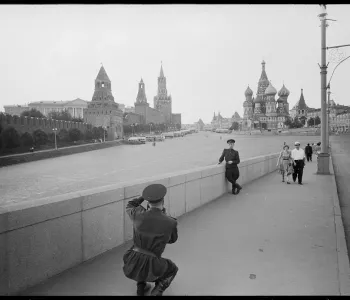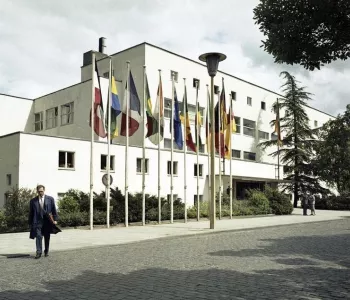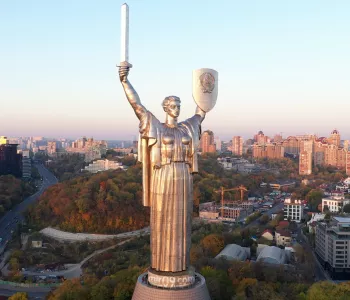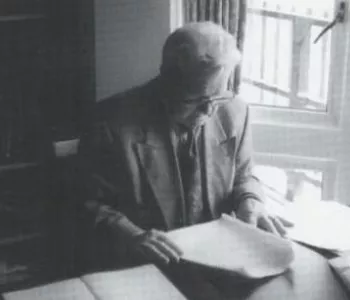d'Vinci

Mitrokhin, Vasili 1922- 2004
Vasili Nikitich Mitrokhin was a senior archivist for the Soviet Union's foreign intelligence service, the First Chief Directorate of the KGB. Mitrokhin defected to the United Kingdom in 1992

Vasili Nikitich Mitrokhin was born on 3 March 1922 in the village of Yurasovo in Ryazan oblast (central Russia). Throughout his life he retained a deep attachment to his roots, although the family moved to Moscow, where he was educated. On leaving school, he briefly attended an artillery academy. Before the outbreak of war he was enrolled in the History and Archives Institute (Istoriko-Arkhivnyy Institut - IAI) in Moscow, founded in 1935 to train archivists for a variety of state and public institutions.
Following Hitler's invasion in the summer of 1941, Stalin's Supreme Command (the Stavka) ordered the general evacuation of all vulnerable industrial plants, research establishments and national cultural institutions to remote areas. The decree governing' the evacuation of Moscow caused the IAI to move en bloc to Alma-Ata (now Almaty) in Kazakhstan, which became a haven for much of the Moscow and Leningrad cultural and scientific elite.
After his first year with the IAI, Mitrokhin transferred to the Kharkov Higher Juridical Institute, which had also been evacuated to Kazakhstan ahead of the German conquest of Ukraine.
On graduating in Kharkov in 1944, he was initially appointed a police lawyer, attached to the military procurator's office. The role evidently brought him to the notice of the MGB (predecessor of the KGB), which nominated him for a three-year course at the Higher Diplomatic School in Moscow, to prepare him for a career in foreign intelligence.
His new career began in 1948, with his assignment to the Committee of Information (the body which controlled foreign intelligence operations from October 1947 to November 1951). This brought him one substantial undercover appointment to the Middle East before the death of Stalin. With the establishment of the KGB, in March 1954, Mitrokhin was given further short term assignments abroad, notably as escort to the Soviet Olympic team at Melbourne, October 1956.
Thereafter, Mitrokhin's career lay with the foreign intelligence archives, within the First Chief Directorate and in the KGB headquarters at Karlshorst in the GDR. From June 1972 he personally supervised the removal of KGB archives from the old Lubyanka headquarters to Yasenevo, off the Moscow ring road. The most sensitive part of the operation consisted of checking each of the Directorate S (Illegals) files consigned to the archives.
At this stage, Mitrokhin began to take extensive manuscript notes of the papers which passed through his hands. At great risk, he smuggled these out and secreted them under the floor of his suburban dacha (log cabin). Over time, he sorted the material thematically in a large number of brown envelopes. Following his retirement in 1984, he organised the manuscript material geographically, and proceeded to type out systematic studies of KGB operations in key parts of the world (beginning with Afghanistan and Iran). In all, he produced 10 volumes of typescript, together with some 30 envelopes of unprocessed manuscript notes. All this was brought to London, when he and his family were exfiltrated from the Soviet Union by the Secret Intelligence Service (SIS) in 1992.
Once in London, Mitrokhin continued to transcribe his manuscript notes. The 10 Moscow-typed volumes and a further 26 volumes typed in London provided the basis for collaboration with Christopher Andrew, yielding two volumes of The Mitrokhin Archive (Penguin Press, 1999 and 2005).
His intention, however, was to publish the bulk of his original archive material, primarily for a Russian academic readership. Besides the area studies (edited and published by the Cold War International History Project of the Woodrow Wilson International Center for Scholars in Washington, D.C.), Vasili Mitrokhin planned to produce a "Chekisms" trilogy, an anthology of decrees and case histories from the 1917 Cheka to the mid-1980s KGB. He was still selecting original material from his extensive manuscript archive at the time of his death in January 2004.









